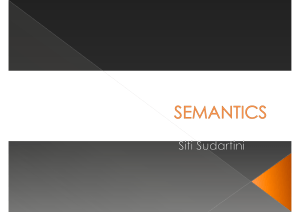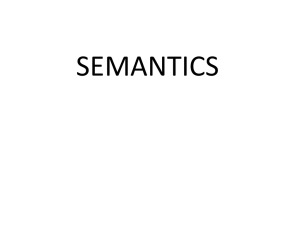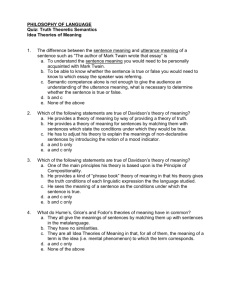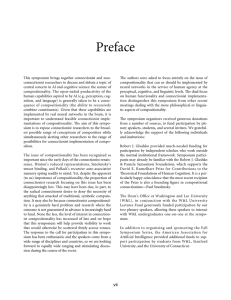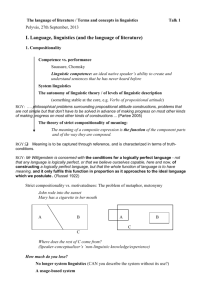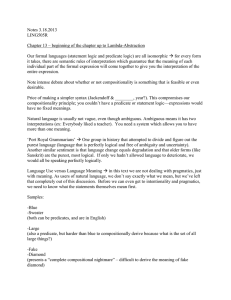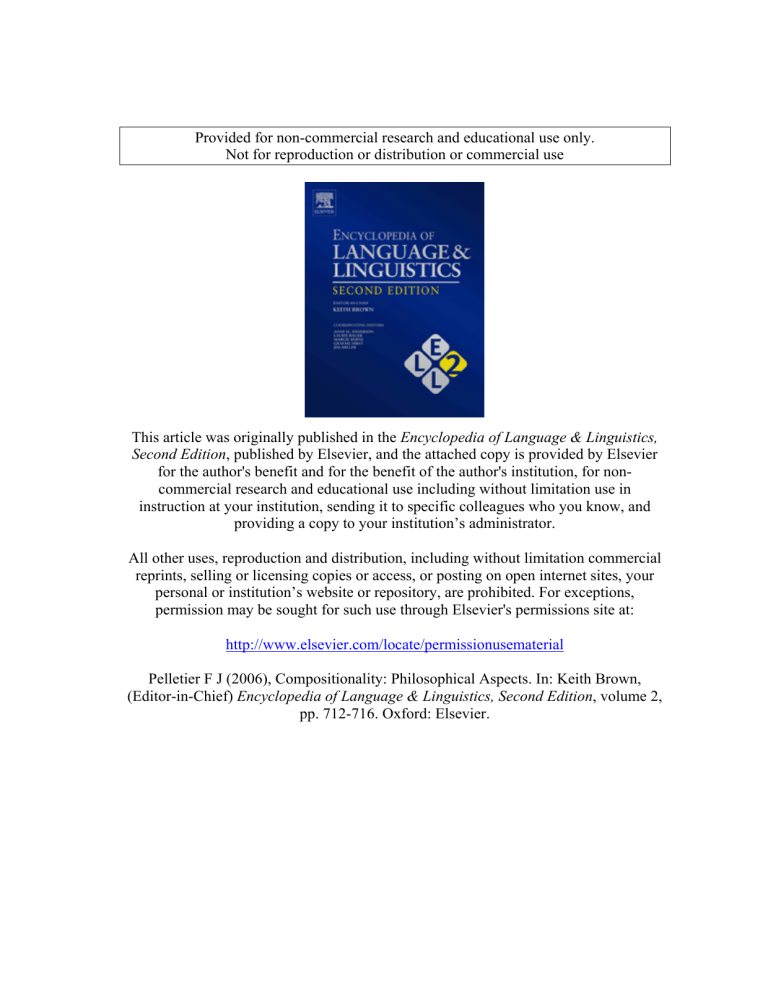
Provided for non-commercial research and educational use only.
Not for reproduction or distribution or commercial use
This article was originally published in the Encyclopedia of Language & Linguistics,
Second Edition, published by Elsevier, and the attached copy is provided by Elsevier
for the author's benefit and for the benefit of the author's institution, for noncommercial research and educational use including without limitation use in
instruction at your institution, sending it to specific colleagues who you know, and
providing a copy to your institution’s administrator.
All other uses, reproduction and distribution, including without limitation commercial
reprints, selling or licensing copies or access, or posting on open internet sites, your
personal or institution’s website or repository, are prohibited. For exceptions,
permission may be sought for such use through Elsevier's permissions site at:
http://www.elsevier.com/locate/permissionusematerial
Pelletier F J (2006), Compositionality: Philosophical Aspects. In: Keith Brown,
(Editor-in-Chief) Encyclopedia of Language & Linguistics, Second Edition, volume 2,
pp. 712-716. Oxford: Elsevier.
712 Componential Analysis
C
op
y
Coseriu E (1967). ‘Lexikalische Solidaritäten.’ Poetica 1,
293–303.
Dowty D (1979). Word meaning and Montague grammar.
Dordrecht: Reidel.
Fillmore C (1975). ‘An alternative to checklist theories of
meaning.’ In Cogen C, Thompson H & Wright J (eds.)
Proceedings of the First Annual Meeting of the Berkeley
Linguistics Society. Berkeley, CA: Berkeley Linguistics
Society. 123–131.
Geckeler H (1971). Zur Wortfelddiskussion. Munich:
Fink.
Geeraerts D, Grondelaers S & Bakema P (1994). The
structure of lexical variation. Berlin: Mouton de
Gruyter.
Goodenough W (1956). ‘Componential analysis and the
study of meaning.’ Language 32, 195–216.
Greimas A (1966). Sémantique structurale. Paris: Larousse.
Heger K (1964). Monem, Wort, Satz und Text. Tübingen:
Niemeyer.
Hjelmslev L (1953). Prolegomena to a theory of language.
Bloomington: Indiana University Press.
Jackendoff R (2002). Foundations of language. Oxford:
Oxford University Press.
Katz J J (1972). Semantic theory. New York: Harper and
Row.
Katz J J & Fodor J A (1963). ‘The structure of a semantic
theory.’ Language 39, 170–210.
Leech G (1974). Semantics. Harmondsworth, England:
Penguin.
Lehrer A (1974). Lexical fields and semantic structure.
Amsterdam: North Holland.
Lipka L (2002). English lexicology. Tübingen: Niemeyer.
Lounsbury F (1956). ‘A semantic analysis of Pawnee kinship usage.’ Language 32, 158–194.
Lutzeier P (1981). Wort und Feld. Tübingen: Niemeyer.
Pottier B (1964). ‘Vers une sémantique moderne.’ Travaux
de Linguistique et de Littérature 2, 107–137.
Pottier B (1965). ‘La définition sémantique dans les dictionnaires.’ Travaux de Linguistique et de Littérature 3,
33–39.
Pustejovsky J (1995). The generative lexicon. Cambridge,
MA: MIT Press.
Weinreich U (1966). ‘Explorations in semantic theory.’ In
Sebeok T A (ed.) Current Trends in Linguistics 3. The
Hague: Mouton. 395–477.
on
al
conversely, if the ‘referential connection’ problem
could be solved for primitive features, the same solution might very well be applicable to words as a
whole. So, if noncircularity does not solve the referential problem as such, decomposition is not a priori
to be preferred over nondecompositional approaches,
and psychological evidence for one or the other can
be taken into account (see Aitchison, 2003 for an
overview of the psychological issues).
However, even within those approaches that do not
consider semantic decomposition to be epistemologically indispensable, componential analysis may be
used as a heuristic device. For instance, in Geeraerts
et al. (1994), a work that is firmly situated within the
tradition of cognitive semantics, the internal prototypical structure of lexical categories is analyzed on
the basis of a componential analysis of the referents of
the words in question.
It would seem, in other words, that there is widespread agreement in linguistics about the usefulness
of componential analysis as a descriptive and heuristic tool, but the associated epistemological view that
there is a primitive set of basic features is generally
treated with much more caution.
Pe
rs
See also: Cognitive Semantics; Lexical Fields; Natural
Semantic Metalanguage; Semantic Primitives.
Bibliography
Au
th
or
's
Aitchison J (2003). Words in the mind: an introduction to
the mental lexicon (3rd edn.). Oxford: Blackwell.
Baldinger K (1980). Semantic theory. Oxford: Blackwell.
Bierwisch M (1969). ‘On certain problems of semantic
representations.’ Foundations of Language 5, 153–184.
Bolinger D (1965). ‘The atomization of meaning.’
Language 41, 555–573.
Conklin H (1955). ‘Hanunóo color categories.’ Southwestern Journal of Anthropology 11, 339–344.
Coseriu E (1964). ‘Pour une sémantique diachronique
structurale.’ Travaux de Linguistique et de Littérature
2, 139–186.
Compositionality: Philosophical Aspects
F J Pelletier, Simon Fraser University,
Burnaby, BC, Canada
ß 2006 Elsevier Ltd. All rights reserved.
There are three different but loosely related conceptions that are associated with the term ‘compositionality’ in the literature of philosophical and linguistic
semantics.
One conception, taking its lead from the more
literal sense of this technical term, concerns the manner of composition of objects in the world. In this
sense, an object or type of object is compositional if it
is identical with its parts when they are assembled in
some specified way. A slogan for this notion of compositionality is: ‘‘An object is the sum of its parts.’’
However, this is a slightly misleading slogan, because
Encyclopedia of Language & Linguistics (2006), vol. 2, pp. 712–716
Compositionality: Philosophical Aspects 713
on
al
C
op
y
the first conception applies to the background syntax,
this second conception presupposes basic or primitive
meanings for the atomic (syntactic or mental) parts
out of which all other (syntactic or mental) items are
composed. (Once this second notion of compositionality is acknowledged, where there is a presupposed
part-whole structure and it is then asked whether a
feature of the whole is somehow determined by the
similar features in the parts, one can see questions of
compositionality arising in many fields, not just in
semantics. For example, one might wonder whether
the intrinsic value of an action is determined by the
values of the parts of the action and the way the parts
are ordered. One might wonder whether the beauty of
a whole is determined by the beauty of its parts and
the way the parts are combined. One might wonder
whether the duties and obligations of a corporation
or a society are determined by those of its members
and the way these members fit together to form the
corporation or society.)
Obviously, whether semantic compositionality is
true or false depends upon the presupposed syntax or
mental economy, the conception of meaning under
consideration, and what is meant by the phrase ‘‘is
determined by.’’ Indeed, many theorists have thought
that this indeterminism inherent in semantic compositionality shows that its truth or falsity is merely
‘‘a methodological matter.’’ For a small alteration in
the underlying syntax or mental economy might make
a given semantics become non-compositional; a slight
change in the assumed notion of ‘determination’ might
make it become compositional again; an inclusion or
exclusion of some property as ‘‘being semantic meaning’’ (as opposed, say, to ‘‘being pragmatics’’) makes
it become non-compositional again; and there might
be no reason to make these changes other than to
keep or deny compositionality.
The most popular explanation of ‘‘is determined
by’’ in the semantic compositionalist’s slogan is that
it means ‘is a (mathematical) function of’; so the
slogan becomes: ‘‘The meaning of a complex syntactic unit is a (mathematical) function of the meanings
of its syntactic parts and the way in which they are
syntactically combined.’’ But according to some, this
notion allows too much: it is claimed that if no constraints are put upon the function, nearly any meanings of parts and syntactic combination can be
compositionally related to the meaning of a whole.
Some theorists would want to make the function be
natural or systematic (and so on), without saying
much about what, exactly and in the abstract,
would make a function be natural or systematic.
More usual is to be given examples of what sort of
mathematical function should be ruled out. Consider
the idea that an adjective like red means something
Au
th
or
's
Pe
rs
it does not distinguish between two different types
of objects made of the same parts but put together
differently. This notion of compositionality is metaphysical in nature: it provides a characterization of
the ontology of objects in the world, saying that they
can all be described in terms of some basic atomic
elements and their combinations. Along with this
ontological feature often goes an epistemological feature: that one can know objects in the world by
understanding what the atomic items are and the
ways they can be assembled. Both the ontological
and the epistemological aspects here are further associated with reductionism: the view that objects are
‘‘nothing more than’’ their parts. In this meaning of
compositionality, the compositionalists are often
called ‘atomists,’ and anti-compositionalists are
called ‘holists’ or sometimes ‘wholists.’ These latter
theorists deny that all objects can be described and
known in terms of their parts and the arrangement of
the parts – for instance, they might deny that a corporation, a nation, or a group is ‘‘nothing more than’’
the class of individuals making them up together with
their relationships – and hence they are antireductionistic. They might also hold that there are emergent
properties and gestalt properties that cannot be described and known in the way required by atomism.
A slogan for these theories is: ‘‘The whole is more
than the sum of its parts.’’
In the field of semantics, whether semantics of
natural language or of mental items, there is a somewhat different conception of compositionality in play.
In this realm, it is meaning that is claimed to be
compositional; but since meaning is always meaning
of something, it is this other something that defines
the parts and the whole, unlike the case of the first
sort of compositionality. The slogan for this second
conception of compositionality is: ‘‘The meaning of
a whole is determined by the meaning of its parts and
the way these parts are combined.’’ What we see
here is that a feature of a whole (its meaning) is
claimed to be determined by the similar feature in
the parts of the whole, plus the mode of combination
of these parts – unlike the case of the first type of
compositionality, in which it was the whole itself
that was alleged to be ‘‘nothing more than’’ its parts.
In the second type of compositionality, the notions of
‘part’ and ‘whole’, as well as their mode of combination, are presupposed to be already defined in terms
of an independent syntax (in the case of language)
or an independent mental economy (in the case of
concepts). So the realm of syntax or mental economy
is presupposed to be compositional in the first sense,
and the issue is whether the property of meaning that
is associated with the parts and wholes will likewise
compose. Since the second conception assumes that
Encyclopedia of Language & Linguistics (2006), vol. 2, pp. 712–716
714 Compositionality: Philosophical Aspects
considerations that might be called ‘the magic of
language’. A set of closely related considerations
have been pointed at in various times in the history
of philosophy, both Western and Indian:
op
y
. We can understand an infinite number of novel
sentences, so long as they employ words we already
understand. We understand sentences and combinations that we have never encountered.
. We can create new sentences that we have never
heard or used before, and we know that they are
appropriate to the situation in which we use them.
. We are finite creatures who are exposed to a finite
amount of information concerning our language.
Nonetheless, we learn a system that is capable of
infinite expression.
C
These considerations all point to the same features:
(1) that language is something special (infinite, novel,
creative, or whatever) and (2) that people manage
to use/learn/understand language despite their finite
nature. It is natural to see compositionality as an
explanation of this ability – people have a finite
stock of atomic items whose meanings are learned
primitively, and there is a finite number of rules of
combination whose effect on meaning are learned.
But given that the rules are recursive in nature, this
allows for an infinite number of sentences whose
meanings are finitely knowable. (The opening paragraph of Frege [1923] is often taken to be an endorsement of this argument for compositionality, but it
is a matter of scholarly dispute as to whether or not
Frege actually believed in semantic compositionality.
See Pelletier, 2001 and Janssen, 2001 for discussion
and further references.)
This third conception of (semantic) compositionality is a ‘functional’ one and thus less definite
than the preceding two. It amounts to saying that
compositionality is whatever accounts for the magic
of language. It might be the second conception of
compositionality, with its mathematical functions,
that will do the trick, or it might be some other,
more exotic type of function. Or it may be some
function that operates on items that are not necessarily syntactic subparts of the expression to be evaluated, and somehow thereby brings in information
from context (of both linguistic and nonlinguistic
varieties).
The magic of language considerations are the only
arguments in favor of compositionality that do not
seem merely to turn on such methodological considerations as the aesthetics of the syntax-semantics
interface. However, it should be noted that they are
not conclusive in relation to compositionalityas-mathematical-function. The second notion of compositionality does not guarantee the magic, nor does
Au
th
or
's
Pe
rs
on
al
different depending on what noun it modifies. For
example, according to this view, red wine vs. red
rose vs. red hair vs. red skin vs. red grapefruit all
employ a different meaning of red. And then compositionality is false, because these phrases are all constructed by the same syntactic rule and yet the
meaning of red changes as a result of some syntactic
item (viz., the noun being modified) that is not a part
of the lexical item red. But a defender of compositionality could respond that the meaning of red is
constant throughout, by being disjunctive (‘‘when
modifying wine it means r1; when modifying hair it
means r2; etc.’’). This is a perfectly good mathematical function and would obviously yield the right
meanings of wholes if there were enough disjuncts.
Those who object to the mathematical notion of function in the definition of compositionality might claim
here that disjunctive functions are ‘‘not natural.’’
The notion opposed to semantic compositionality
is ‘semantic holism’. However, this notion means different things to different theorists, and it is not always
just taken to mean merely that there is no mathematical function that will generate the required meanings.
For example, some people call semantic holism the
view that ‘‘words have meaning only in the context of
a sentence’’ or that no word or other syntactic unit
(including sentences, paragraphs, and discourses) has
meaning in itself, but only in the setting of an entire
theory or worldview or form of life. Others take
semantic holism to be that the meaning of a syntactically defined item is determined not only by the
meanings of its syntactic parts and their syntactic
combination but also by the nonlinguistic context in
which the utterance is made. (For example, it might
be thought that the meaning of There is no money
depends on who is speaking, whether the audience
knows which business deal is being discussed, and so
forth.) And still other holists, not necessarily wanting
to bring these nonlinguistic items into meaning, nonetheless might hold that there are cases where the
meaning of a syntactically complex item depends on
meanings of linguistic items that are not syntactic
parts of the complex. (For example, in The first man
landed on the moon in 1969, we cannot take the
meaning of the first man and combine it with landed
on the moon in 1969 to get the right meaning, for
there is no sense in which the sentence really is talking
about the first man. Rather, the relevant meaning of
the subject term is that of the first man who landed on
the moon. But to obtain that meaning, we need to get
information from the verb phrase. Hence, to get the
meaning of the subject term we need information of
items that are not syntactic parts of the subject term.)
A third conception for (semantic) compositionality
is less definite than the preceding, and comes through
Encyclopedia of Language & Linguistics (2006), vol. 2, pp. 712–716
Compositionality: Philosophical Aspects 715
Au
th
or
's
y
op
Pe
rs
The linguistic semantics literature is rife with demonstrations of how some linguistic phenomenon can or
cannot be given a compositional description. It often
seems that these works would more accurately be
described as demonstrating how a phenomenon can
or cannot be given a compositional description
employing some particular syntactic-semantic device
or within some specific syntactic-semantic theory.
There are, however, three more general arguments
that have been presented against semantic compositionality. The first is an argument from (nonlinguistic)
context, of the sort mentioned above, where it is
claimed that the meaning of a sentence in a context
just cannot be derived from the meanings of the
words and their combinations. In evaluating this argument, scholars need to distinguish between (what
might be called) ‘literal meaning’ and ‘occasion
meaning’. The former is thought of as the meaningin-language, while the latter is thought of as the
meaning-in-a-context. If there is such a distinction,
then there will be two principles of semantic compositionality – one for each type of meaning. And it is
not so clear that either of them is overturned by
considerations of context. The only casualty would
be a mixed principle that no one believes, i.e., that the
occasion meaning of a complex expression is a mathematical function of the literal meanings of its parts
and their manner of combination.
The second general argument against compositionality comes from the existence of synonymy and
Mates-like (Mates, 1950) considerations. Given that
there is synonymy, so that x1 and x2 mean the same,
then there are two sentences, S1 and S2, that differ
only in that one contains x1 while the other contains
x2. Given compositionality, it follows that S1 and S2
are synonymous too; and by compositionality again,
it follows that Mary believes S1 and Mary believes S2
C
Considerations Against Semantic
Compositionality
are synonymous. But for any such S1 and S2, it can be
the case that the former is true, while the latter is
false. However, it cannot be the case that, of two
synonymous sentences, one is true and the other false.
Hence, either there is no synonymy or else compositionality is wrong. And the existence of synonymy
is more secure than that of compositionality.
The third general argument comes from the existence of ambiguity. If compositionality implies that
the meaning of a whole is a mathematical function of
the meanings of its parts (and combination), then
there cannot be any ambiguity of the sort where one
and the same item has two or more meanings, for that
would deny that it was a function that computed
meaning. As with synonymy, one could of course
deny the existence of ambiguity; but most theorists
find that this is too lavish a position to take. So it is
usually admitted by compositionalists that individual
words can be ambiguous; therefore, sentences using
these ambiguous words may also be ambiguous (but
the ambiguities are always traceable to the ambiguity
of the words). Also, it is pointed out that strings
of words such as Visiting professors can be fun are
ambiguous (is it the professors or the activity of
visiting the professors that can be fun?), but this
ambiguity is traceable to the fact that the words are
put together in different ways – that is, there are
different structural descriptions that can be associated with this string of words. Hence, this ambiguity is not a challenge to compositionality. However,
Pelletier (1994/2004) points to a number of examples
that seem neither to have ambiguous words nor to
have different structural descriptions but which are
nonetheless ambiguous. For example: When Alice
rode a bicycle, she went to school. This seems to
have but one syntactic analysis within any particular
theory, but its meaning is ambiguous: On those occasions where Alice rode a bicycle, she took it to school
vs. Back in the days when Alice was a bicyclist, she
was a student.
on
al
non-compositionality in this second notion necessarily deny the magic. For it might be that the meaning of
every syntactic whole is a function of the meanings of
its parts and its syntactic mode of combination, but if
these functions are not computable functions, then
the language cannot be learned/used/understood in
the way required by the magic. On the other hand,
even if there is no function defined solely by the
meanings of the parts and their modes of combination
that will yield the meanings of the wholes, it could
nonetheless be true that these meanings are computable in some other way . . . and then the magic
would still be there. (An example of this possibility
is Pelletier’s 1994/2004 ‘semantic groundedness’.)
Formal Considerations
There have been a number of works concerned with
the question of whether compositionality is a nonempirical issue on the grounds of certain formal features
that are required by compositionality. A review article that surveys this work is Westerståhl (1998). More
recent work on formal features of compositional semantics is in the important work of Hodges (2001)
and material based on this.
History
Although the general principle of compositionality
seems to have been around for some time, as
Encyclopedia of Language & Linguistics (2006), vol. 2, pp. 712–716
716 Compositionality: Philosophical Aspects
th
or
's
Pe
rs
on
al
Davidson D (1965). ‘Theories of meaning and learnable
languages.’ In Bar-Hillel Y (ed.) Logic, methodology
and philosophy of science. Amsterdam: North Holland.
383–394.
Dever J (in press). ‘Compositionality.’ In Lepore E &
Smith B (eds.) Oxford handbook of the philosophy of
language. Oxford: Oxford University Press.
Fodor J & Lepore E (1992). Holism: a shopper’s guide.
Oxford: Blackwell.
Fodor J & Lepore E (2002). The compositionality papers.
New York: Oxford University Press.
Frege G (1923/1963). ‘Compound thoughts.’ Stoothoff R
(trans.). Mind 72, 1–17.
Hodges W (2001). ‘Formal features of compositionality.’
Journal of Logic, Language and Information 10, 7–28.
Janssen T (1997). ‘Compositionality.’ In van Benthem J &
ter Meulen A (eds.) Handbook of logic and language.
Amsterdam: Elsevier. 417–473.
Janssen T (2001). ‘Frege, contextuality and compositionality.’ Journal of Logic, Language and Information 10,
115–136.
y
Bibliography
op
See also: Context Principle; Holism, Semantic and Epistemic; Human Language Processing: Connectionist Models;
Reductionism; Representation in Language and Mind;
Systematicity.
Kamp H & Partee B (1995). ‘Prototype theory and compositionality.’ Cognition 57, 129–191.
Katz J (1973). ‘Compositionality, idiomaticity, and lexical
substitution.’ In Anderson S & Kiparsky P (eds.)
A festschrift for Morris Halle. New York: Holt, Rinehart,
and Winston. 357–376.
Mates B (1950). ‘Synonymity.’ California University Publications in Philosophy 25. Reprinted in Linsky L (1952).
Semantics and the philosophy of language. Urbana:
University of Illinois Press. 111–136.
Pagin P (1997). ‘Is compositionality compatible with
holism?’ Mind and Language 12, 11–23.
Partee B (1984). ‘Compositionality.’ In Landman F &
Veltman F (eds.) Varieties of formal semantics.
Dordrecht: Foris. 281–311.
Partee B (2003). Compositionality in formal semantics:
selected papers by Barbara H. Partee. Oxford: Blackwell.
Pelletier F J (1994/2004). ‘The principle of semantic compositionality.’ Topoi 13, 11–24. [Reprinted with new
appendices in Davis S & Gillon B (eds.) Semantics: a
reader. New York: Oxford University Press. 133–158.]
Pelletier F J (2001). ‘Did Frege believe Frege’s principle?’
Journal of Logic, Language and Information 10, 87–114.
Smuts J (1926). Holism and evolution. London: Macmillan.
Szabo Z (2000). Problems of compositionality. New York:
Garland.
Thomason R (1974). ‘Introduction.’ In Thomason R (ed.)
Formal philosophy: selected papers of Richard Montague. New Haven: Yale University Press. 1–69.
Westerståhl D (1998). ‘On mathematical proofs of the vacuity of compositionality.’ Linguistics and Philosophy
21, 635–643.
Westerståhl D (2002). ‘Idioms and compositionality.’ In
Barker-Plummer D, Beaver D, van Benthem J & Scotto
di Luzio P (eds.) Words, proofs, and diagrams. Stanford:
CSLI Publications. 241–271.
C
mentioned earlier, it is not clear when the term ‘compositionality’ came into the linguistic semantics literature (unlike ‘holism,’ which was introduced by
Smuts, 1926). ‘Compositionality’ is used by Katz
(1973) and Thomason (1974).
Compositionality: Semantic Aspects
Au
G Sandu and P Salo, University of Helsinki,
Helsinki, Finland
ß 2006 Elsevier Ltd. All rights reserved.
According to the principle of compositionality, the
meaning of a complex expression depends only on
the meanings of its constituents and on the way these
constituents have been put together. The kind of dependence involved here is usually a functional one.
Principle of Compositionality (PC): The meaning of
complex expression is a function of the meanings of
its constituents and of the rule by which they were
combined.
PC is rather vague unless one specifies the meanings
of ‘is a function of’ and ‘meaning(s)’, something that
is easier said than done. A more rigorous formulation
of these notions is possible for formal languages and
is due to Richard Montague.
Montague (1974) defined compositionality as the
requirement of the existence of a homomorphism
between syntax and semantics, both to be understood
as ‘structures’ in the mathematical sense. To keep
technicalities down to a minimum, Montague’s
requirement of a compositional interpretation was
that for each syntactic operation ‘O’ that applies to
n expressions e1, . . ., en in order to form the complex
expression ‘O(e1, . . ., en)’, the interpretation of the
complex expression ‘Oi(e1, . . ., en)’ is the result of
the application of the semantic operation ‘Ci’, which
is the interpretation of ‘Oi’ to the interpretations
m1, . . ., mn of ‘e1’, . . .,‘en’, respectively. In other
Encyclopedia of Language & Linguistics (2006), vol. 2, pp. 712–716


